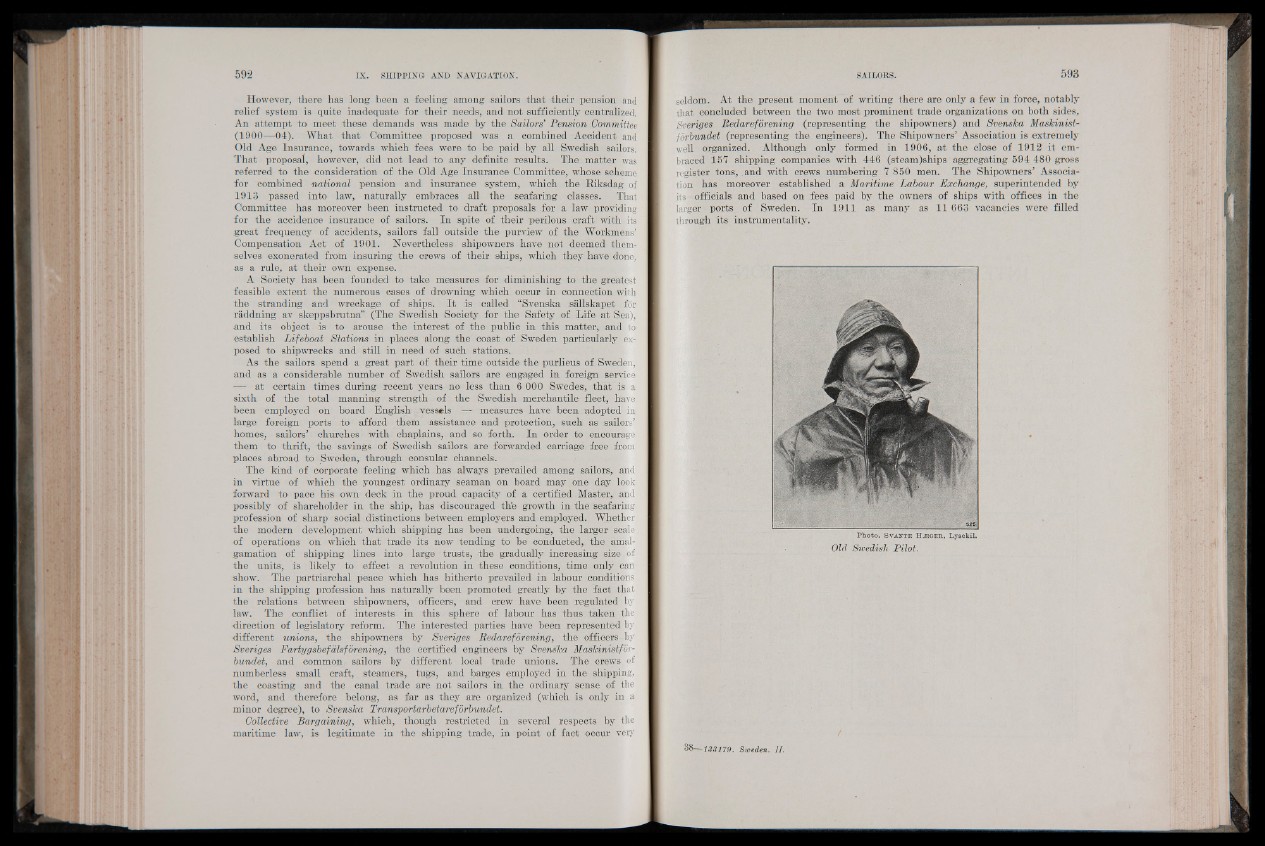
However, there has long been a feeling among sailors that their pension and
relief system is quite inadequate for their needs, and not sufficiently centralized.
An attempt to meet these demands was made by the Sailors’ Pension Committee
(1900—04). What th a t Committee proposed was a combined Accident and
Old Age Insurance, towards which fees were to be paid by all Swedish sailors.
That proposal, however, did not lead to any definite results. The matter was
referred to the consideration of the Old Age Insurance Committee, whose scheme
for combined national pension and insurance system, which the Riksdag of
1913 passed into law, naturally embraces all the seafaring classes. That
Committee has moreover been instructed to draft proposals for a law providing
for the accidence insurance of sailors. In spite of their perilous craft with its
great frequency of accidents, sailors fall outside the purview of the Workmens'
Compensation Act of 1901. Nevertheless shipowners have not deemed themselves
exonerated from insuring the crews of their ships, which they have done,
as a rule, at their own expense.
A Society has been founded to take measures for diminishing to the greatest
feasible extent the numerous cases of drowning which occur in connection with
th e stranding and wreckage of ships. I t is called “Svenska sallskapet for
raddning av skeppsbrutna” (The Swedish Society for the Safety of Life at Sea),
and its object is to arouse the interest of the public in this matter, and to
establish Lifeboat Stations in places along the coast of Sweden particularly exposed
to shipwrecks and still in need of such stations.
As the sailors spend a great part of their time outside the purlieus of Sweden,
and as a considerable number of Swedish sailors are engaged in foreign service
||p i | at certain times during recent years no less than 6 000 Swedes, thatTis a
sixth of the total manning strength of the Swedish merehantile fleet, have
been employed on board Knglish vessels measures have been adopted in
large foreign ports to afford them assistance and protection, such as sailors’
homes, sailors’ churches with chaplains, and so . forth. In order to encourage
them to thrift, the savings of Swedish sailors are forwarded carriage free from
places abroad to Sweden, through consular channels.
The kind of corporate feeling which has always prevailed among sailors, and
in virtue of which the youngest ordinary seaman on board may one day look
forward to pace his own deck in the proud capacity of a certified Master, and
possibly of shareholder in the ship, has discouraged th'e growth in the seafaring
profession of sharp social distinctions between employers and employed. Whether
the modern development which shipping has been undergoing, the larger scale
of operations on which that trade its now tending to be conducted, the amalgamation
of shipping lines into large trusts, the gradually increasing size of
the units, is likely to effect a revolution in these conditions, time only can
show. The partriarchal peace which has hitherto prevailed in labour conditions
in the shipping profession has naturally been promoted greatly by the fact »that
the relations between shipowners, officers, and crew have been regulated by
law. The conflict of interests in this sphere of labour has thus taken the
direction of legislatory reform. The interested parties have been represented by
different unions, the shipowners by Sveriges Bedareforening, the officers by
Sveriges Partygsbefdlsforening, the certified engineers by Svenska Maskinistfor-
bundet, and common sailors by different local trade unions. The crews of
numberless small craft, steamers, tugs, and barges employed in the shipping,
the coasting and the canal trade are not sailors in the ordinary sense of the
word, and therefore belong, as far as they are organized (which is only in a
minor degree), to Svenska Transportarbetarefbrbundet.
Collective Bargaining, which, though restricted in several respects by the
maritime law, is legitimate in the shipping trade, in point of fact occur very
seldom. At the present moment of writing there are only a few in force, notably
that concluded between the two most prominent trade organizations on both sides,
Sveriges Bedareforening (representing the shipowners) and Svenska Maskinist-
f'orbundet (representing the engineers). The Shipowners’ Association is extremely
well organized. Although only formed in 1906, at the close of 1912 it embraced
151 shipping companies with 446 (steam)ships aggregating 594 480 gross
register tons, and with crews numbering 7 850 men. The Shipowners’ Association
has moreover established a Maritime Labour Exchange, superintended by
its «officials and based on fees paid by the owners of ships with offices in the
larger ports of Sweden. In 1911 as many as 11 663 vacancies were filled
through its instrumentality.
Photo. S v a n t e H æ g e r , Lysekil.
Old Swedish Pilot.